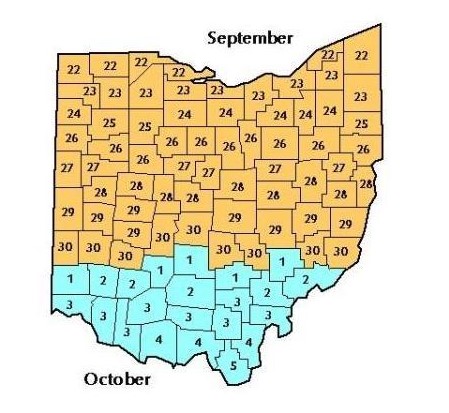By Laura Lindsey and Pierce Paul et.al.
Wheat helps reduce problems associated with the continuous planting of soybean and corn. With soybean harvest quickly approaching, we would like to remind farmers of a few management decisions that are important for a successful crop.

- Variety Selection. Select high-yielding varieties with high test weight, good straw strength, and adequate disease resistance. Do not jeopardize your investment by planting anything but the best yielding varieties that also have resistance to the important diseases in your area. Depending on your area of the state, you may need good resistance to powdery mildew, Stagonospora leaf blotch, and/or leaf rust. Avoid varieties with susceptibility to Fusarium head scab. Plant seed that has been properly cleaned to remove shriveled kernels and treated with a fungicide seed treatment to control seed-borne diseases. The 2020 Ohio Wheat Performance Test results can be found at: https://www.oardc.ohio-state.edu/wheattrials/
- Planting Date. Plant after the Hessian Fly Safe Date for your county. This date varies between September 22 for northern counties and October 5 for southern-most counties (Figure 1). Planting before the Fly Safe Date increases the risk of insect and disease problems including Hessian fly and aphids carrying Barley Yellow Dwarf Virus. The best time to plant is within 10 days after the Fly Safe Date.
- Seeding Rate. Optimum seeding rates are between 1.2 and 1.6 million seeds per acre. For drills with 7.5-inch row spacing, this is about 18 to 24 seeds per foot of row. When wheat is planted on time, actual seeding rate has little effect on yield, but high seeding rates (above 30 seeds per foot of row) increase lodging and the risk of severe powdery mildew development next spring.
- Planting Depth. Planting depth is critical for tiller development and winter survival. Plant seed 1.5 inches deep and make sure planting depth is uniform across the field. No-till wheat seeded into soybean stubble is ideal, but make sure the soybean residue is uniformly spread over the surface of the ground. Shallow planting is the main cause of low tiller numbers and poor over-winter survival due to heaving and freeze injury.
- Fertilizer Application. Apply 20 of nitrogen per acre before planting to promote fall tiller development. Do not apply more than 10 lb N per acre as urea in contact with seed. A soil test should be completed to determine phosphorus and potassium needs. Wheat requires more phosphorus than corn or soybean, and soil test levels should be maintained between 30-50 ppm (Mehlich-3 P) for optimum production. If the soil test indicates less than 30 ppm, then apply 80 to 110 pounds of P2O5 at planting, depending on yield potential. Do not add any phosphorus if soil test levels are higher than 50 ppm. Soil potassium should be maintained at 120 to 170 ppm (Mehlich-3 K) for soils with a cation exchange capacity >6 meq/100 g). For sandy soils with a cation exchange capacity of <5 meq/100 g, soil potassium should be maintained at 100 to 130 ppm. If potassium levels are low, apply between 65 to 180 pounds of K2O at planting, depending on the soil cation exchange capacity and yield potential. Soil pH should be between 6.3 and 7.0. In Ohio, limed soils usually have adequate calcium and magnesium. Sulfur should be added in the spring to sandy soils and soils with low organic matter. Ohio research from the past several years has not shown a yield response to supplemental sulfur on medium to fine-textured soils that have adequate organic matter. For the recently revised Tri-State Fertilizer Recommendations for Corn, Soybeans, Wheat, and Alfalfa see: https://agcrops.osu.edu/FertilityResources/tri-state_info